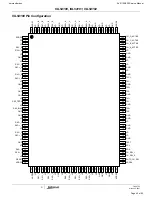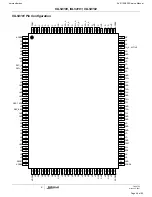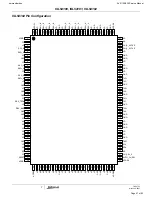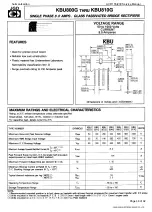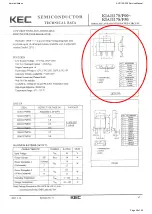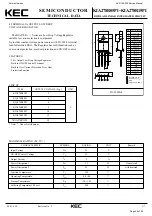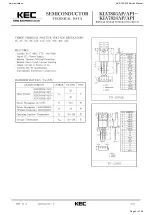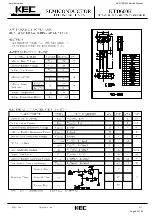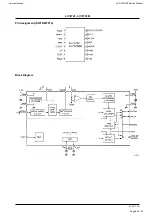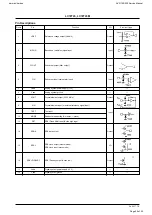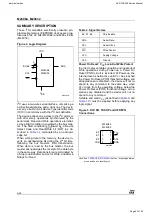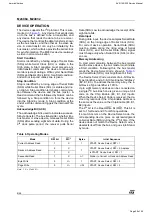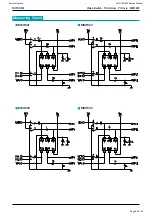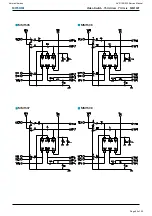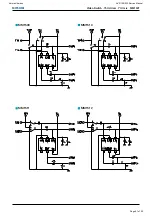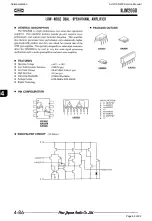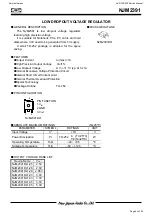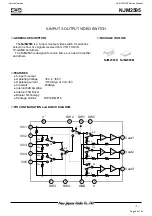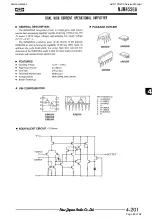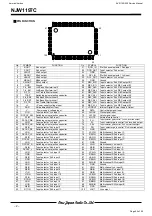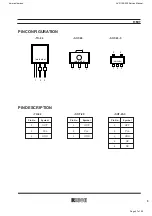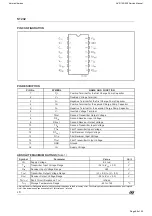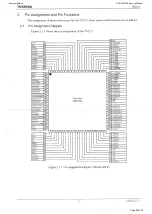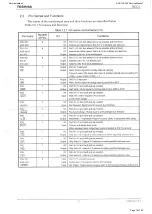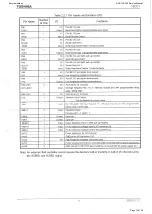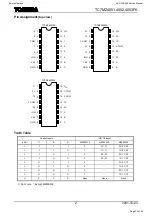
M24C64, M24C32
8/26
DEVICE OPERATION
The device supports the I
2
C protocol. This is sum-
. Any device that sends data
on to the bus is defined to be a transmitter, and
any device that reads the data to be a receiver.
The device that controls the data transfer is known
as the bus master, and the other as the slave de-
vice. A data transfer can only be initiated by the
bus master, which will also provide the serial clock
for synchronization. The M24Cxx device is always
a slave in all communication.
Start Condition
Start is identified by a falling edge of Serial Data
(SDA) while Serial Clock (SCL) is stable in the
High state. A Start condition must precede any
data transfer command. The device continuously
monitors (except during a Write cycle) Serial Data
(SDA) and Serial Clock (SCL) for a Start condition,
and will not respond unless one is given.
Stop Condition
Stop is identified by a rising edge of Serial Data
(SDA) while Serial Clock (SCL) is stable and driv-
en High. A Stop condition terminates communica-
tion between the device and the bus master. A
Read command that is followed by NoAck can be
followed by a Stop condition to force the device
into the Stand-by mode. A Stop condition at the
end of a Write command triggers the internal Write
cycle.
Acknowledge Bit (ACK)
The acknowledge bit is used to indicate a success-
ful byte transfer. The bus transmitter, whether it be
bus master or slave device, releases Serial Data
(SDA) after sending eight bits of data. During the
9
th
clock pulse period, the receiver pulls Serial
Data (SDA) Low to acknowledge the receipt of the
eight data bits.
Data Input
During data input, the device samples Serial Data
(SDA) on the rising edge of Serial Clock (SCL).
For correct device operation, Serial Data (SDA)
must be stable during the rising edge of Serial
Clock (SCL), and the Serial Data (SDA) signal
must change
only
when Serial Clock (SCL) is driv-
en Low.
Memory Addressing
To start communication between the bus master
and the slave device, the bus master must initiate
a Start condition. Following this, the bus master
sends the Device Select Code, shown in
(on Serial Data (SDA), most significant bit first).
The Device Select Code consists of a 4-bit Device
Type Identifier, and a 3-bit Chip Enable “Address”
(E2, E1, E0). To address the memory array, the 4-
bit Device Type Identifier is 1010b.
Up to eight memory devices can be connected on
a single I
2
C bus. Each one is given a unique 3-bit
code on the Chip Enable (E0, E1, E2) inputs.
When the Device Select Code is received, the de-
vice only responds if the Chip Enable Address is
the same as the value on the Chip Enable (E0, E1,
E2) inputs.
The 8
th
bit is the Read/Write bit (RW). This bit is
set to 1 for Read and 0 for Write operations.
If a match occurs on the Device Select code, the
corresponding device gives an acknowledgment
on Serial Data (SDA) during the 9
th
bit time. If the
device does not match the Device Select code, it
deselects itself from the bus, and goes into Stand-
by mode.
Table 6. Operating Modes
Note: 1. X =
V
IH
or V
IL
.
Mode
RW bit
WC
1
Bytes
Initial Sequence
Current Address Read
1
X
1
START, Device Select, RW = 1
Random Address Read
0
X
1
START, Device Select, RW = 0, Address
1
X
reSTART, Device Select, RW = 1
Sequential Read
1
X
≥
1
Similar to Current or Random Address Read
Byte Write
0
V
IL
1
START, Device Select, RW = 0
Page Write
0
V
IL
≤
32
START, Device Select, RW = 0
harman/kardon
AVR 155/230 Service Manual
Page 58 of 92
Содержание AVR 155/230
Страница 37: ...harman kardon AVR 155 230 Service Manual Page 37 of 92...
Страница 40: ...harman kardon AVR 155 230 Service Manual Page 40 of 92...
Страница 48: ...harman kardon AVR 155 230 Service Manual Page 48 of 92...
Страница 49: ...harman kardon AVR 155 230 Service Manual Page 49 of 92...
Страница 51: ...harman kardon AVR 155 230 Service Manual Page 51 of 92...
Страница 52: ...harman kardon AVR 155 230 Service Manual Page 52 of 92...
Страница 53: ...harman kardon AVR 155 230 Service Manual Page 53 of 92...
Страница 56: ...harman kardon AVR 155 230 Service Manual Page 56 of 92...
Страница 62: ...harman kardon AVR 155 230 Service Manual Page 62 of 92...
Страница 65: ...harman kardon AVR 155 230 Service Manual Page 65 of 92...
Страница 69: ...harman kardon AVR 155 230 Service Manual Page 69 of 92...
Страница 70: ...harman kardon AVR 155 230 Service Manual Page 70 of 92...
Страница 71: ...harman kardon AVR 155 230 Service Manual Page 71 of 92...
Страница 72: ...harman kardon AVR 155 230 Service Manual Page 72 of 92...
Страница 74: ...harman kardon AVR 155 230 Service Manual Page 74 of 92...
Страница 75: ...harman kardon AVR 155 230 Service Manual Page 75 of 92...
Страница 76: ...harman kardon AVR 155 230 Service Manual Page 76 of 92...
Страница 77: ...harman kardon AVR 155 230 Service Manual Page 77 of 92...
Страница 78: ...harman kardon AVR 155 230 Service Manual Page 78 of 92...
Страница 79: ...harman kardon AVR 155 230 Service Manual Page 79 of 92...
Страница 80: ...harman kardon AVR 155 230 Service Manual Page 80 of 92...
Страница 81: ...harman kardon AVR 155 230 Service Manual Page 81 of 92...
Страница 82: ...harman kardon AVR 155 230 Service Manual Page 82 of 92...
Страница 83: ...AVR155 WIRING sch 1 Wed Mar 12 14 07 28 2008 harman kardon AVR 155 230 Service Manual Page 83 of 92...
Страница 85: ...AVRx54 Front_0119 sch 1 Fri Feb 08 15 10 47 2008 harman kardon AVR 155 230 Service Manual Page 85 of 92...
Страница 86: ...harman kardon AVR 155 230 Service Manual Page 86 of 92...
Страница 87: ...harman kardon AVR 155 230 Service Manual Page 87 of 92...
Страница 88: ...harman kardon AVR 155 230 Service Manual Page 88 of 92...
Страница 89: ...harman kardon AVR 155 230 Service Manual Page 89 of 92...
Страница 90: ...harman kardon AVR 155 230 Service Manual Page 90 of 92...
Страница 91: ...harman kardon AVR 155 230 Service Manual Page 91 of 92...
Страница 92: ...AVR154 VIDEO_20071230 1 sch 1 Fri Feb 08 15 07 04 2008 harman kardon AVR 155 230 Service Manual Page 92 of 92...


